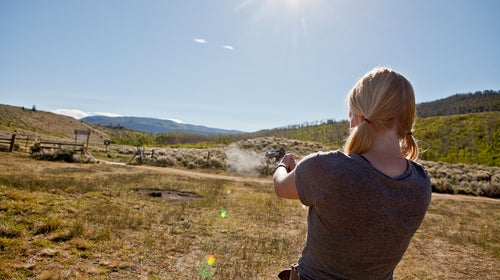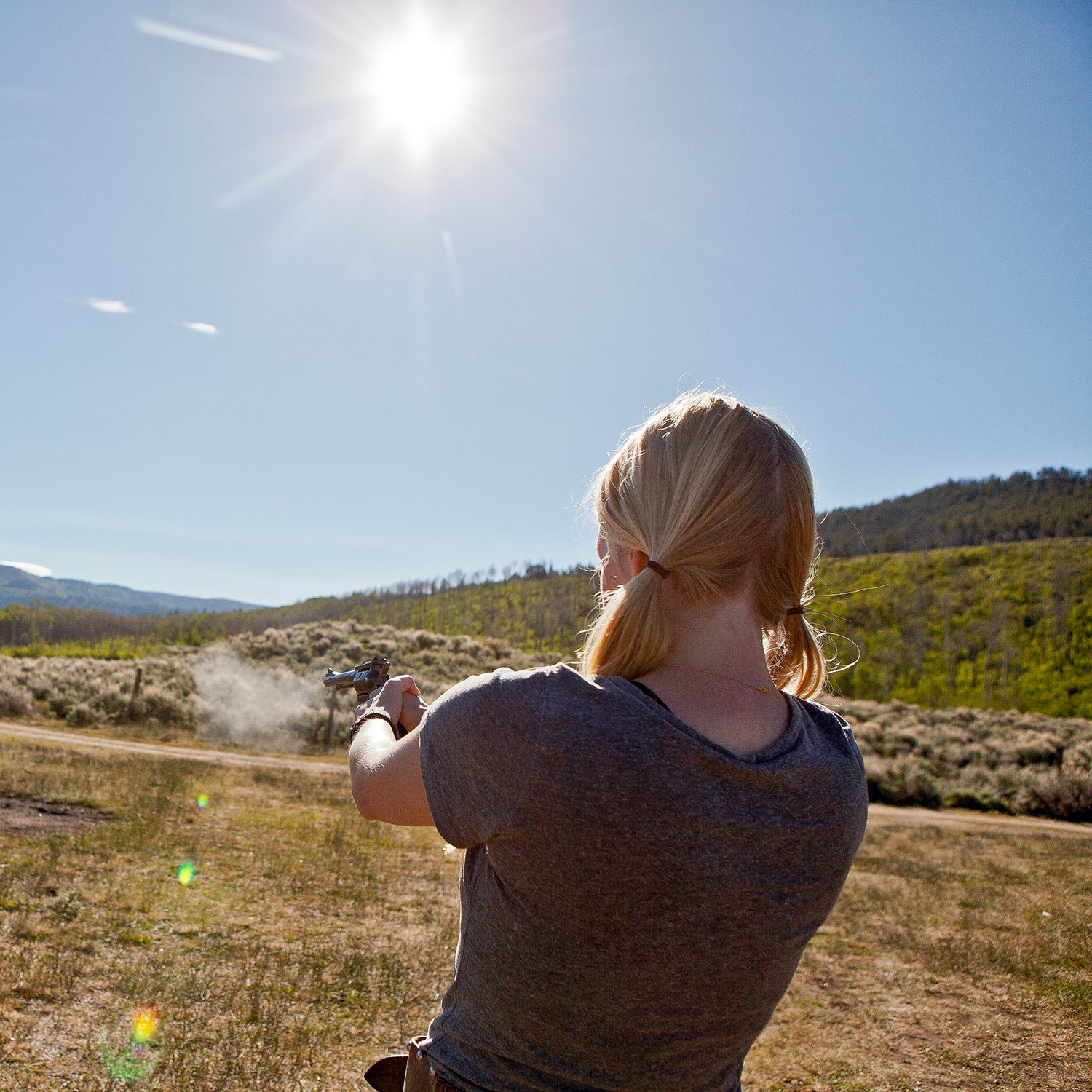Earlier this month, a thru-hiker was stabbed to death on the Appalachian Trail in Virginia. After a few cursory moments of thoughts and prayers, the internet started offering suggestions that hikers arm themselves with guns.
Comments on the �����ԹϺ��� social-media channels ranged from thoughtful to truly paranoid, but what surprised most me was��how many people claimed to carry a gun on the trails�� to Wes Siler’s 2018 piece about whether or not to carry a firearm��in the backcountry��(he ultimately argues that nonlethal defense is a better option). Many, it seems, fancy themselves pretty savvy gunslingers: Is that Wild Bill Hickock or Jeremy from accounting? It’s hard to tell. And that scares me far more than any grizzly bear or random hiker I’m likely to encounter. Anonymous recreationists carrying guns should scare you, too.
I’m not anti-gun, nor am I a city-dwelling ideologue. I’ve lived in Montana for nearly 20 years, and��I own guns. The only time I carry one into the woods, however, is to hunt. To kill game. That’s what they’re built to do.
I’ve been an outdoor writer and editor for nearly as long, covering everything from skiing and climbing to hunting and fishing. I own a backcountry guide service and operate exclusively in grizzly country, including some of the most bear-dense parts��of Yellowstone. I’ve had dozens of grizzly encounters, run-ins with polar bears on Arctic ski expeditions, and more than a few awkward conversations with disturbed individuals over the years—all sans sidearm and no worse for wear. Some of these experiences were scary, but I’ve never pulled the trigger on my bear spray (much less a pistol), and every one of those encounters made me a better outdoorsman.
The only fact that truly matters is irrefutable: the more firearms present in a situation, the greater chance you have of being injured or killed. Period.
I’ve also worked as an armed courier, transporting millions of dollars in an armored Freightliner—a job that required defensive-firearms training and certification with law enforcement and former military contractors. Guns were part of my wardrobe, and I’m comfortable with almost any firearm you could put in my hand. It’s guns in other peoples’ hands that make me nervous.
I’m not going to cite statistics about rifles and pistols or their effectiveness in wilderness-self-defense scenarios (the outcomes are generally piss-poor). The only fact that truly matters is irrefutable: the more firearms present in a situation, the greater chance you have of being injured or killed. Period. This isn’t a guns-in-America discussion. This is about whether it’s necessary or reasonable to carry them while recreating on public land and trails.
Are We in Danger?
We are not in danger on our favorite hiking trails and in our national forests. In fact, these places are ridiculously safe. While the recent murder on the AT is tragic, it was also an incredibly rare event. According to the Appalachian Trail Conservancy, which manages and preserves the trail, between two million and three million people hike part or all of the AT every year (over 5,000 are registered for nonstop thru-hikes this year alone), and yet in 45 years of record keeping, just . The most recent murder was only the third since 2000. If you extrapolate an average of two million hikers per year since the turn of the century, that equates to a murder rate of roughly 0.008 per 100,000 hikers.
In my backyard, grizzly bears roam freely, as they should. Sure, each year bears maul people, but most incidents are predictable and preventable: the elk hunter creeping around in the fall��when bears are stockpiling calories for winter,��the habituated bear feeding in urban areas,��the surprised sow with cubs. These are outlier events, not an assault on humanity. We are statistically very, very safe on the AT, in grizzly country, and everywhere else we recreate outside. I bet my life on it nearly every day.
Still, some people will insist they need a gun just in case. This means one of two things: they are completely terrified of some unspecified threat, or they simply like guns because they’re cool��and want to carry one. That is completely legal in most cases. But what is legal and what is reasonable are often not the same.
Why Carrying a Gun Is��Unnecessary and Dumb
There are three practical reasons why carrying a gun in the backcountry is silly.
First, any responsible��owner knows that the highest priority is the security of their weapon at all times. On the trail, that becomes a real issue, since there’s no way to safely store your weapon. Want to go for a quick swim? Sorry, you can’t leave your sidearm unattended. Need to head into town for a resupply? Public transportation is off-limits, and most businesses don’t allow firearms. Want to grab a cold beer at the local watering hole after a particularly humid stretch of trail? Bummer, because in most states guns��aren’t allowed in bars.
Second, hikers and backpackers are notorious gram counters. Are you seriously going to agonize for months over how to save a few grams on your stove, tent, and shoes, and then pack two pounds of loaded pistol on your hip? You may as well carry an external frame pack and a canvas-wall tent.
Finally, and most importantly, carrying a gun changes the way we interact with and feel about others. For thru-hikers, the social element is an enormously rewarding part of the experience. They meet people from around the world, adopt kooky trail names, share information (including who might be sketchy or carrying a weapon), and coexist for a brief time in a remarkable place, doing a remarkable thing. Bring a firearm into that dynamic, and it won’t be the same. Others don’t know you—they don’t know your training, demeanor, judgment, or intelligence. All they know is that you have a weapon��and, with it, the power to hurt them. And that’s all that truly matters. Guns intimidate.
There Are Better Ways to Stay Safe
The most important defensive training I received had nothing to do with how to apply deadly force. One of my instructors (a former Army Ranger) told us that if you need to improvise a defensive situation, it’s probably already too late. Whether it’s a charging bear, a person with a knife, or a terrorist with a bomb, if we’re reacting to a situation, we’ve already lost.
A gun is not the cure for fear.
Situational awareness and anticipation are the keys to avoiding trouble, and these are the best tools we have to remain safe in any environment. They are what we used to safeguard all that cash when I was an armed courier��and what I use daily to keep my clients safe in the backcountry.
Do research before you embark on any adventure. Identify threats—bears, people, weather, fire. Educate yourself on these threats. Be alert, and note the details of your surroundings and the people you encounter. Something feel off? It probably is; change your strategy. It’s easier to avoid a dangerous situation than it is to escape one.
There are courses for this stuff, so rather than buy a handgun, take a class in developing situational awareness. If you hike in grizzly country, take a bear safety and behavior course, and practice deploying your bear spray. This makes it easier to identify a legitimate threat, and the beauty of bear spray is that if you pull the trigger and your judgment is poor, no one is dead. But whether it’s a bear or a knife-wielding assailant, they will not be a threat after a lungful of pepper.
A gun is not the cure for fear. Guns��treat the symptoms of fear by making us feel safer and more powerful. But like water on a grease fire, they tend to escalate conflict rapidly. And if you’re in a defensive position, you probably won’t come out ahead.
Please, for the sake of the rest of us—the good guys on the trail—don’t carry a gun. It makes it awfully hard to tell who the good guys are. Going for a hike, run, or bike ride in the woods is incredibly safe. Let go of the fear.


